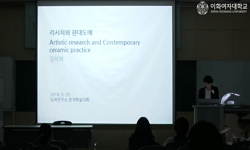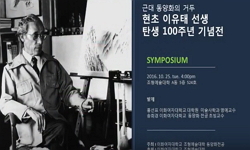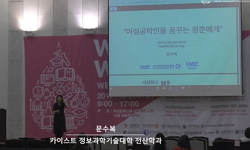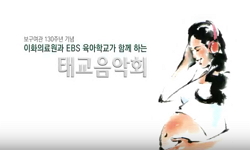한국의 현대도예는 대한민국 정부가 수립된 이후 점진적으로 그 형태를 갖추게 되었다. 격동기를 겪은 이후 체계적인 문화정책과 현대화를 위한 문화예술계의 타율적인 조화는 전통의 올바...
http://chineseinput.net/에서 pinyin(병음)방식으로 중국어를 변환할 수 있습니다.
변환된 중국어를 복사하여 사용하시면 됩니다.
- 中文 을 입력하시려면 zhongwen을 입력하시고 space를누르시면됩니다.
- 北京 을 입력하시려면 beijing을 입력하시고 space를 누르시면 됩니다.
한국 현대도예와 이화여자대학교(梨花女子大學校) : 전통도자의 현대적 재해석과 조형도자에 대한 모색 = Korean Contemporary Ceramics and Ewha Womans university : Contemporary Reinterpretation of Traditional Ceramics and Search for Formative Ceramics
한글로보기https://www.riss.kr/link?id=A107167163
- 저자
- 발행기관
- 학술지명
- 권호사항
-
발행연도
2020
-
작성언어
-
- 주제어
-
자료형태
학술저널
-
수록면
7-29(23쪽)
- 제공처
- 소장기관
-
0
상세조회 -
0
다운로드
부가정보
국문 초록 (Abstract)
특히 이화의 도예교육은 1960~70년대 전통을 강조하는 국가정책과 관련 사업에 주목하면서도 전통의 의미부여를 다양한 각도에서 재조명하는데 주력하였다. 초대 교육자로서 황종구교수가 부임하면서 청자를 비롯한 각종 전통자기에 대한 과학적인 실험과 재현이 성공적으로 이루어졌고, 이를 바탕으로 현대적인 감각과 조형에 대한 탐구를 위한 교육과정 및 연구가 이루어진 것이다. 1970년대 중반 이후, 급격한 도예 인구의 증가로 현대도예계는 이전과 다른 구조를 갖추게 되었으며, 특히 조형도자의 수용은 기존 도예문화를 변화시키기에 충만했다. 이화의 교육은 이 같은 흐름을 포괄하면서 한면으로는 기존의 교육을 유지하는 가운데 현대도예의 발전과 비전을 지속적으로 제시하였다.
따라서 1959년부터 시작된 이화여대의 도예교육과 연구는 한국의 전통성과 현대성을 결합, 융화하는 가운데 거듭나며 오늘에 이르렀고, 향후에도 이와 같은 도예문화를 확장하여 한국 도예의 발전에 기여할 것이다.
한국의 현대도예는 대한민국 정부가 수립된 이후 점진적으로 그 형태를 갖추게 되었다. 격동기를 겪은 이후 체계적인 문화정책과 현대화를 위한 문화예술계의 타율적인 조화는 전통의 올바른 계승과 고형도자의 수용이라는 이분화 된 맥락 속에서 점진적으로 전개되었다. 특히1960년대 전반까지도 전통도자는 전승의 대상을 넘어 창작의 주요 영역으로 인정하는 양상이 만연하였고, 이화여대는 관련 교육을 도입하며 올바른 도예교육을 지향하고자 하였다. 즉 1959년 한국 대학에서는 최초로 전통도자의 현대화와 계승의 중요성을 인지하면서 관련 도예교육을 시작한 이화여대는 당시의 시기적 요구에 적극 부흥하였다.
특히 이화의 도예교육은 1960~70년대 전통을 강조하는 국가정책과 관련 사업에 주목하면서도 전통의 의미부여를 다양한 각도에서 재조명하는데 주력하였다. 초대 교육자로서 황종구교수가 부임하면서 청자를 비롯한 각종 전통자기에 대한 과학적인 실험과 재현이 성공적으로 이루어졌고, 이를 바탕으로 현대적인 감각과 조형에 대한 탐구를 위한 교육과정 및 연구가 이루어진 것이다. 1970년대 중반 이후, 급격한 도예 인구의 증가로 현대도예계는 이전과 다른 구조를 갖추게 되었으며, 특히 조형도자의 수용은 기존 도예문화를 변화시키기에 충만했다. 이화의 교육은 이 같은 흐름을 포괄하면서 한면으로는 기존의 교육을 유지하는 가운데 현대도예의 발전과 비전을 지속적으로 제시하였다.
따라서 1959년부터 시작된 이화여대의 도예교육과 연구는 한국의 전통성과 현대성을 결합, 융화하는 가운데 거듭나며 오늘에 이르렀고, 향후에도 이와 같은 도예문화를 확장하여 한국 도예의 발전에 기여할 것이다.
다국어 초록 (Multilingual Abstract)
In particular, Ewha's ceramic education focused on national policy and related projects that emphasized the traditions of the 1960s and 1970s, while focusing on rethinking the meaning of traditions from various angles. As the first educator, Professor HwangJong-gu(황종구) was appointed as a first-time educator, and scientific experiments and representations were successfully performed on celadon and various other traditional ceramics. Since the mid 1970s, the rapid increase in the pottery population has resulted in a structure different from that of the modern ceramic art industry. In particular, the acceptance of formative ceramics was sufficient to change the existing ceramic culture. Ewha's education encompassed this trend and, on the other hand, maintained the existing education and continuously presented the development and vision of Modem Ceramic Art.
Therefore, ceramic education and research at Ewha Womans University, which started in 1959, has been reborn as a combination of Korean tradition and modernity, and will continue today, and will continue to expand this pottery culture to contribute to the development of Korean Ceramic.
Korea's Modern Ceramic gradually took its form after the Korean government was established. After the turbulent period, the systematic cultural policy and the harmonious harmonization of the cultural and art world for modernization gradually developed...
Korea's Modern Ceramic gradually took its form after the Korean government was established. After the turbulent period, the systematic cultural policy and the harmonious harmonization of the cultural and art world for modernization gradually developed in the dichotomous context of the correct succession of tradition and the acceptance of formative ceramics. In particular, even in the early 1960s, traditional ceramics were recognized as a major area of creation beyond the object of tradition, and Ewha Womans University tried to aim for correct pottery education by introducing related education. In other words, Ewha Womans University, which first started teaching related pottery in 1959, recognizing the importance of modernization and succession of traditional ceramics, actively revived the needs of the time.
In particular, Ewha's ceramic education focused on national policy and related projects that emphasized the traditions of the 1960s and 1970s, while focusing on rethinking the meaning of traditions from various angles. As the first educator, Professor HwangJong-gu(황종구) was appointed as a first-time educator, and scientific experiments and representations were successfully performed on celadon and various other traditional ceramics. Since the mid 1970s, the rapid increase in the pottery population has resulted in a structure different from that of the modern ceramic art industry. In particular, the acceptance of formative ceramics was sufficient to change the existing ceramic culture. Ewha's education encompassed this trend and, on the other hand, maintained the existing education and continuously presented the development and vision of Modem Ceramic Art.
Therefore, ceramic education and research at Ewha Womans University, which started in 1959, has been reborn as a combination of Korean tradition and modernity, and will continue today, and will continue to expand this pottery culture to contribute to the development of Korean Ceramic.
동일학술지(권/호) 다른 논문
-
도자예술의 새로운 테크닉을 통한 현대화 : 1980년대 이화여자대학교를 중심으로
- 이화여자대학교 도예연구소
- 김주연 ( Jooyeon Kim )
- 2020
-
이화여자대학교 조형예술 학부 도자예술전공의 교과편성 연구 : 1990년부터 2010년을 중심으로
- 이화여자대학교 도예연구소
- 조은미 ( Eunmi Cho )
- 2020
-
융합과 개념공상예술 : 융합적 시대상을 바탕으로 한 도예의 영역적응사례 연구
- 이화여자대학교 도예연구소
- 김아영 ( Ah-young Kim )
- 2020
-
시대 변화와 도예교육의 확장 : 공예매개인력 양성 교육
- 이화여자대학교 도예연구소
- 김지혜 ( Jihye Kim )
- 2020




 RISS
RISS KISS
KISS







